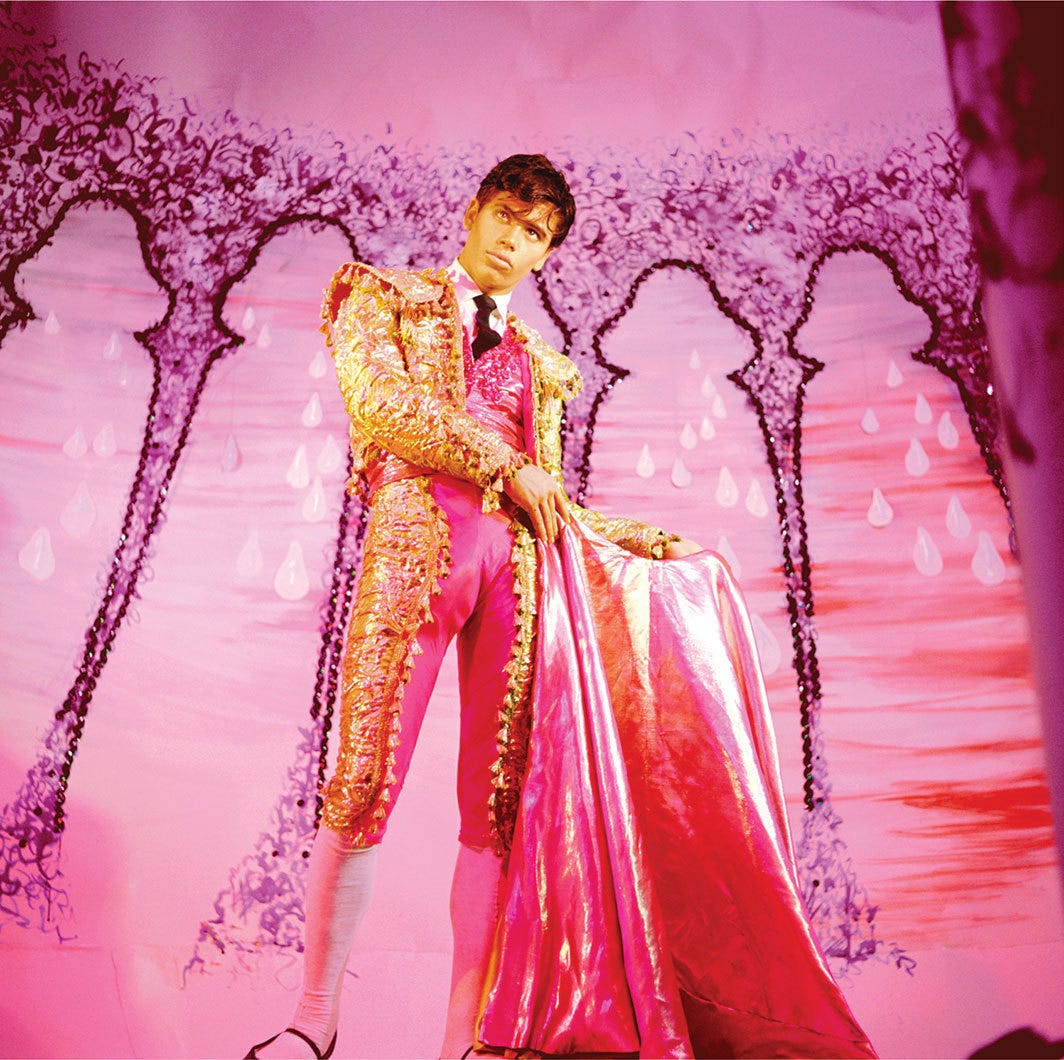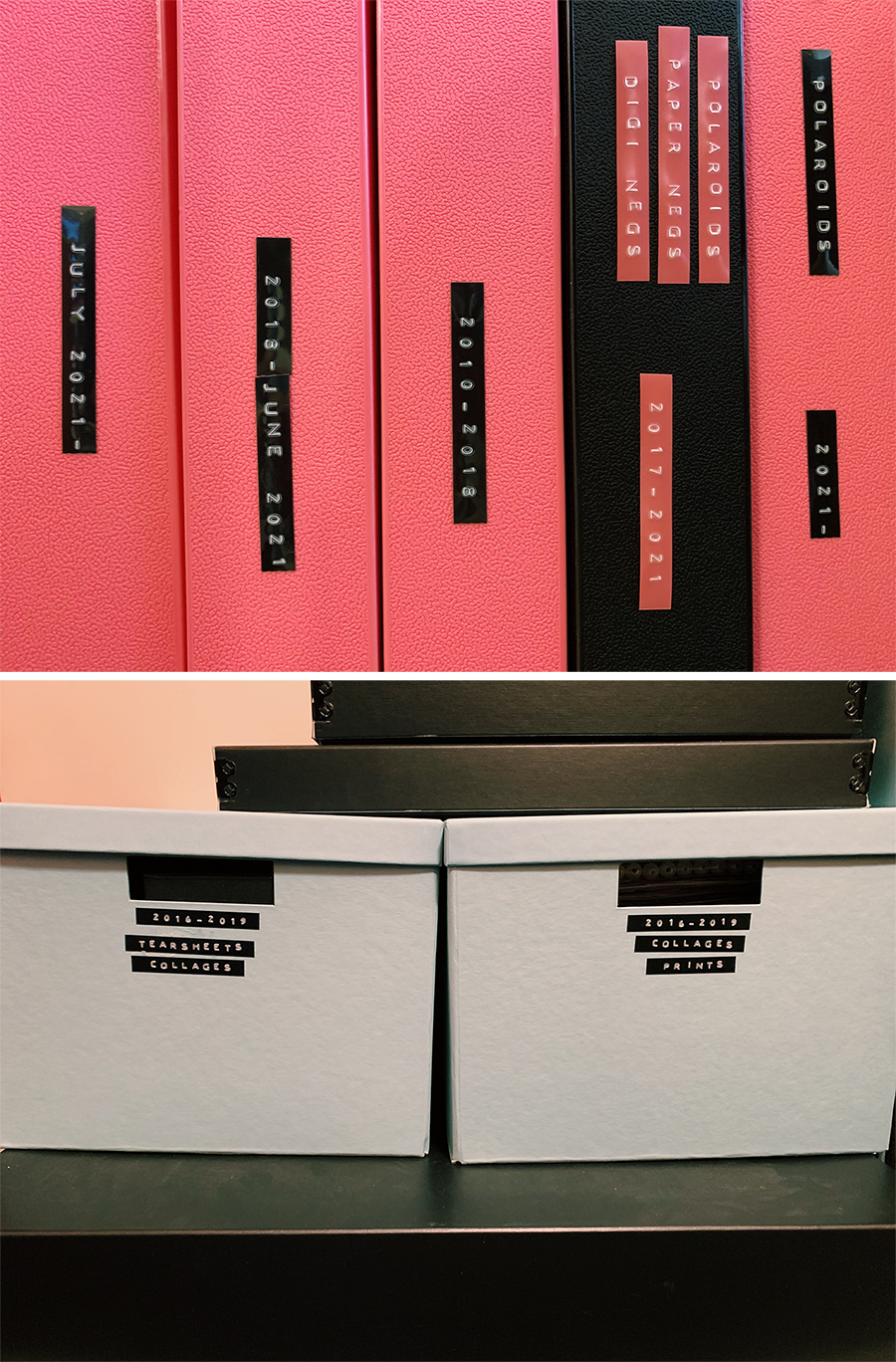What I've learned from queer surrealist photographer James Bidgood
Plus, a plea for all artists to archive their work, and info about my archiving process too
Hi guys,
Man, I had all kinds of grand plans to make this newsletter about album art and packaging (in its most maximal iterations), but before I sat down to start writing I learned that one of my favorite photographers of all time passed away at 88- RIP to the prince of glitter, rainbow light, and beautiful, cherubic boys, James Bidgood. I’m going to hold off on the album art stuff this week and talk about James and why I love his work + what I’ve learned from researching him and studying his work. I really believe that if you like my work at all, you’ll probably love his.

A little bit of background before I get into it- I was introduced to Bidgood’s work through my friend Barry when I was in college. I was deep in the process of understanding my queer identity, diving into learning about queer art throughout history, and working hard on my Identity Crisis series (which is a series of self portraits that I was using at the time to better understand my queerness and what exactly it looks like for me). Bidgood’s work immediately hit me hard- it was so clear in looking at these rainbow lit, glittery, paper mache’d sets that his work was the precursor to some of my favorite artists like David LaChapelle and Pierre et Gilles. It’s the earliest instance I can find of what we’re now calling “Petra Collins lighting”- he was doing this shit in the early 60s! Can you IMAGINE.

I feel like we (we being artists that use camp aesthetics in any capacity) all owe so much to James and his style; he was doing intentional camp before Sontag ever published Notes on Camp, he was a drag performer, a theater costume designer, set designer, and a filmmaker. His work is so surreal, so BIG, but at the same time maintains a completely handmade aesthetic that for me, made fabricating my own fantasies seem possible. I think beyond any of the queer themes and beauty in the work, his legacy is in the DIY beauty of his work (to me). A reminder that we can do SO much with so little.
Here are a few things that I’ve learned from James Bidgood, mixed in with some of my favorite pieces of his work.


You gotta make something out of nothing
Maybe the most impressive, inspiring thing about him is that he built the majority of the sets in his photos 1. by himself 2. with no real budget and 3. in his tiny Manhattan apartment. He sewed costumes himself, reused props over and over, and used materials like fabric, chicken wire, aluminum foil, and paper mache to create his dream worlds. I read that he would sometimes sleep in the sets when space got cramped. It’s hard but it’s possible! His work is such a beautiful reminder that you can make MAGIC out of barely anything. I know I’ve been screaming this from the rooftops for a long time, but god!!!! It’s so true!!!
I think about all of the times I’ve stressed about not having enough space or money to execute my vision and now looking back at his massive body of work, I’m remembering that I’m bullshitting myself- art is about problem solving and making something out of nothing. That’s LITERALLY WHAT ARTISTS DO!!!! It’s a perfect reminder that if something is truly important to you and needs to be in the world (and if you’re wildly driven), you’ll find a way to make it happen. Regardless of money or time or supplies or space.
I know that the handmade aesthetics of Bidgood’s work were born out of necessity because of the restraints he was creating under, but that’s the most magical part of his work, I think. It makes fantasy seem touchable- even if you don’t look at the photos and immediately see them within their context, you can see a human hand in all of the beauty. I feel like this is a great example of how sometimes a lack of resources can morph into a signature style- it can add something new and fresh to the work that wouldn’t have happened if he had access to top of the line supplies and professionals. Use it to your advantage!

Please for the love of god, ARCHIVE YOUR WORK.
Something I’ve read pretty consistently about Bidgood- and to this day the most heartbreaking thing to me- is that his work wasn’t meticulously archived, for the most part. I think about so many of the artists that I love that died years and years before I was even a THOUGHT in this world and how lucky I am to have found their work. This is the result of someone–be it the artist, their estate, art historians, etc–taking the time to go through a lifetime of work and archive it so that future generations can see it/be impacted/have their shit rocked by art. The fact that James’s work is so beyond influential and inspiring and that he hasn’t had the recognition that *I*, selfishly as a huge fan, feel like he deserves, hurts. I want to see his work live on as long as possible. I want multiple hardcover monographs to choose from, I want several major museum retrospectives, I want people to know who he is! Where these beautiful rainbow-lit queer fantasies came from!
I remember watching a Sasha Velour talk years ago (I lost my notes so this is very much [Savana’s Version], no quotes here) around the time she released her art book, Velour, that contains the work from 3 issues of her eponymous magazine. I think I remember her saying something to the effect of: if we don’t take the time to make hard copies of our work and put it into the world, it’s likely not going to survive the test of time. This is especially important for marginalized artists. I’m bastardizing what was probably a really great quote, but I really believe in this sentiment. Your art needs to be protected and distributed so it can live outside of YOU. People. Need. Your. Art. !!!!! Even after you’re long gone!
Also, that said, I don’t think you necessarily have to publish a hardcover book to prolong the life of your work- the internet is a great way to share things and archive them too. But I think there’s real value in physical objects. I think a lot about Riot Grrrl zines and the way that by the sheer volume that were produced, work from that period has been able to live on in collections like the one at NYU, online, and in tons of private collections because the artists/writers had a will to get their work into the world (and people loved it and kept it). People on Etsy sell versions of Kathleen Hanna’s zines that have been photocopied over and over since the 90s- it’s magical to think that zines that Kathleen made as a teenager on xeroxed sheets of paper are still being loved and reproduced so accessibly in 2022.
I’m going to include my favorite archival products (not spon, just for our like, long term artistic wellbeing) at the end of this newsletter. Take it or leave it, I’m not a master- but I will say that archiving is something that art school really ingrained in me that I’m very thankful for. Please allow me to share that supremely expensive education with you for free. 🙃

Resources for learning more about James and his work
Here are a couple of great obituaries and tributes that speak much more eloquently about him than I can.
Donate to the GoFundMe for James’s funeral expenses and vital archiving costs
My Favorite Archiving Materials (that I have acquired over a span of years, don’t freak)
-Protectors for Polaroids and 4x5 negatives
-Protectors for 6x7 120mm negatives
-Protectors for 35mm negatives
-Protectors for 8x10 and smaller prints and collages
-For odd size and large collages/prints, I layer them between sheets of Glassine Paper, which prevent “acid migration and abrasion”
-Archival binders for film, obvs I buy the pink ones.
-Archival boxes for prints and collages. You can get a variety of sizes!
-I use a Dymo labeler for my boxes.
-Print your work/make collages using nice, archival paper if you can. This is my fav but there are so many other good options.
-Scan every piece of art you make that makes you feel something. Organize your files!
-I will likely die with my LaCie Rugged hard drives in my hands. The photo rule that I was taught is: (1) hard drive at home that lives on your desk, (1) hard drive with the exact same files (a double backup) that you keep on your person. Do frequent, manual backups! Organize your files nicely! I’m not perfect about it, but it does make me feel better to know that I have double backups of my life’s work on virtually indestructible hard drives and that I can find old work pretty quickly.

I know that archiving isn’t very sexy to read about/take the time to do, but give your work the treatment it deserves pleeeease. Every time I go through my archives I, well, 1. Want to gag because there is some OLD, BAD stuff in there but 2. Am really grateful that I’m doing this now so that down the line I won’t have to spend weeks or months looking at past work. Because that’s the real definition of hell :)
Ok that’s all for this one. I’m so thankful that we’re able to access and be inspired by work that was made by non-living artists. But what a privilege it is to be alive at the same time as our heroes <3 <3 <3 I love you forever, James Bidgood!
xoxo









